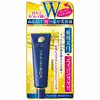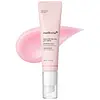What's inside
What's inside
 Key Ingredients
Key Ingredients

 Benefits
Benefits

 Concerns
Concerns

 Ingredients Side-by-side
Ingredients Side-by-side

Placental Extract
Tocopheryl Acetate
AntioxidantCollagen
MoisturisingTripeptide-8
Skin ConditioningCoix Lacryma-Jobi Ma-Yuen Seed Extract
Skin ConditioningDiospyros Kaki Fruit Extract
Skin ConditioningPCA
HumectantAluminum Acetate Solution
AstringentMalic Acid
BufferingOryza Sativa Bran Oil
EmollientGlycosphingolipids
EmollientPhospholipids
Skin ConditioningTocopherol
AntioxidantHydroxyproline
Skin ConditioningGlycerin
HumectantButylene Glycol
Humectant1,5-Pentanediol
SolventPolyglyceryl-2 Oleate
EmulsifyingGlyceryl Stearate
EmollientPolyglyceryl-5 Stearate
EmulsifyingEthylhexyl Palmitate
EmollientBeeswax
Emulsion StabilisingDimethicone
EmollientStearic Acid
CleansingCaprylyl Alcohol
MaskingPolypentaerythrityl C5-10 Acid Esters
Hydrogenated Polybutene
Behenyl Alcohol
EmollientC4-18 Alkyl Methacrylate/Methacryloyloxyethyl Phosphorylcholine Copolymer
HumectantAlcohol Denat.
AntimicrobialPhenoxyethanol
PreservativeSodium Paraben
PreservativeParfum
MaskingPlacental Extract, Tocopheryl Acetate, Collagen, Tripeptide-8, Coix Lacryma-Jobi Ma-Yuen Seed Extract, Diospyros Kaki Fruit Extract, PCA, Aluminum Acetate Solution, Malic Acid, Oryza Sativa Bran Oil, Glycosphingolipids, Phospholipids, Tocopherol, Hydroxyproline, Glycerin, Butylene Glycol, 1,5-Pentanediol, Polyglyceryl-2 Oleate, Glyceryl Stearate, Polyglyceryl-5 Stearate, Ethylhexyl Palmitate, Beeswax, Dimethicone, Stearic Acid, Caprylyl Alcohol, Polypentaerythrityl C5-10 Acid Esters, Hydrogenated Polybutene, Behenyl Alcohol, C4-18 Alkyl Methacrylate/Methacryloyloxyethyl Phosphorylcholine Copolymer, Alcohol Denat., Phenoxyethanol, Sodium Paraben, Parfum
Water
Skin ConditioningGlycerin
HumectantDipropylene Glycol
HumectantNiacinamide
SmoothingCaprylic/Capric Triglyceride
MaskingPentaerythrityl Tetraethylhexanoate
EmollientCetearyl Alcohol
EmollientGlycereth-26
HumectantButylene Glycol Dicaprylate/Dicaprate
EmollientBis-Behenyl/Isostearyl/Phytosteryl Dimer Dilinoleyl Dimer Dilinoleate
EmollientCetearyl Olivate
Sorbitan Olivate
EmulsifyingPropylene Glycol Dibenzoate
Skin ConditioningPullulan
1,2-Hexanediol
Skin ConditioningGlyceryl Stearate
EmollientVinyldimethicone
Hydroxyacetophenone
AntioxidantHydroxyethyl Acrylate/Sodium Acryloyldimethyl Taurate Copolymer
Emulsion StabilisingHydrogenated Lecithin
EmulsifyingSodium Acrylate/Sodium Acryloyldimethyl Taurate Copolymer
Emulsion StabilisingSodium Dna
Skin ConditioningPolyisobutene
Butylene Glycol
HumectantEthylhexylglycerin
Skin ConditioningPropanediol
SolventMelia Azadirachta Leaf Extract
Skin ConditioningAdenosine
Skin ConditioningMelia Azadirachta Flower Extract
Skin ConditioningCurcuma Longa Root Extract
MaskingSorbitan Isostearate
EmulsifyingSorbitan Oleate
EmulsifyingCaprylyl/Capryl Glucoside
CleansingFragaria Chiloensis Fruit Extract
Skin ConditioningHedera Helix Leaf/Stem Extract
AntimicrobialCyanocobalamin
Skin ConditioningCitrus Nobilis Peel Extract
MaskingRetinol
Skin ConditioningOcimum Sanctum Leaf Extract
Skin ConditioningLespedeza Capitata Leaf/Stem Extract
Skin ConditioningCorallina Officinalis Extract
Skin ConditioningSodium Hyaluronate
HumectantCaffeine
Skin ConditioningCoffea Arabica Seed Extract
MaskingHydrolyzed Extensin
Skin ConditioningHydrolyzed Hyaluronic Acid
HumectantCopper Tripeptide-1
Skin ConditioningSodium Acetylated Hyaluronate
HumectantAcetyl Hexapeptide-8
HumectantPalmitoyl Pentapeptide-4
Skin ConditioningPalmitoyl Tetrapeptide-7
Skin ConditioningPalmitoyl Tripeptide-1
Skin ConditioningWater, Glycerin, Dipropylene Glycol, Niacinamide, Caprylic/Capric Triglyceride, Pentaerythrityl Tetraethylhexanoate, Cetearyl Alcohol, Glycereth-26, Butylene Glycol Dicaprylate/Dicaprate, Bis-Behenyl/Isostearyl/Phytosteryl Dimer Dilinoleyl Dimer Dilinoleate, Cetearyl Olivate, Sorbitan Olivate, Propylene Glycol Dibenzoate, Pullulan, 1,2-Hexanediol, Glyceryl Stearate, Vinyldimethicone, Hydroxyacetophenone, Hydroxyethyl Acrylate/Sodium Acryloyldimethyl Taurate Copolymer, Hydrogenated Lecithin, Sodium Acrylate/Sodium Acryloyldimethyl Taurate Copolymer, Sodium Dna, Polyisobutene, Butylene Glycol, Ethylhexylglycerin, Propanediol, Melia Azadirachta Leaf Extract, Adenosine, Melia Azadirachta Flower Extract, Curcuma Longa Root Extract, Sorbitan Isostearate, Sorbitan Oleate, Caprylyl/Capryl Glucoside, Fragaria Chiloensis Fruit Extract, Hedera Helix Leaf/Stem Extract, Cyanocobalamin, Citrus Nobilis Peel Extract, Retinol, Ocimum Sanctum Leaf Extract, Lespedeza Capitata Leaf/Stem Extract, Corallina Officinalis Extract, Sodium Hyaluronate, Caffeine, Coffea Arabica Seed Extract, Hydrolyzed Extensin, Hydrolyzed Hyaluronic Acid, Copper Tripeptide-1, Sodium Acetylated Hyaluronate, Acetyl Hexapeptide-8, Palmitoyl Pentapeptide-4, Palmitoyl Tetrapeptide-7, Palmitoyl Tripeptide-1
 Reviews
Reviews

Alternatives
Ingredients Explained
These ingredients are found in both products.
Ingredients higher up in an ingredient list are typically present in a larger amount.
Butylene Glycol (or BG) is used within cosmetic products for a few different reasons:
Overall, Butylene Glycol is a safe and well-rounded ingredient that works well with other ingredients.
Though this ingredient works well with most skin types, some people with sensitive skin may experience a reaction such as allergic rashes, closed comedones, or itchiness.
Learn more about Butylene GlycolGlycerin is already naturally found in your skin. It helps moisturize and protect your skin.
A study from 2016 found glycerin to be more effective as a humectant than AHAs and hyaluronic acid.
As a humectant, it helps the skin stay hydrated by pulling moisture to your skin. The low molecular weight of glycerin allows it to pull moisture into the deeper layers of your skin.
Hydrated skin improves your skin barrier; Your skin barrier helps protect against irritants and bacteria.
Glycerin has also been found to have antimicrobial and antiviral properties. Due to these properties, glycerin is often used in wound and burn treatments.
In cosmetics, glycerin is usually derived from plants such as soybean or palm. However, it can also be sourced from animals, such as tallow or animal fat.
This ingredient is organic, colorless, odorless, and non-toxic.
Glycerin is the name for this ingredient in American English. British English uses Glycerol/Glycerine.
Learn more about GlycerinGlyceryl Stearate is a mix of glycerin and stearic acid.
It is used to stabilize the mixing of water and oil ingredients. By preventing these ingredients from separating, it can help elongate shelf life. It can also help thicken the product's texture.
As an emollient, it helps soften skin and supports barrier-replenishing ingredients.
In cosmetics, Glyceryl Stearate is often made from vegetable oils or synthetically produced.
This ingredient may not be fungal-acne safe
Fun fact: The human body also creates Glyceryl Stearate naturally.
Learn more about Glyceryl Stearate